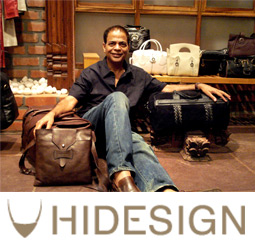"Consumers don't necessarily relate to these reasons, and our continued drumming on how it is good for the world just turns off the customers"
 Dilip Kapur, Founder and President, Hidesign
Dilip Kapur, Founder and President, Hidesign
Hidesign traces its roots to India from 1978, and has become a globally recognized brand today. Its sustainable actions have been admired across the globe, especially in matters of leather. One is bound to come across this brand in high profile retail stores all over the world.
How important is sustainability for Hidesign? What measures does Hidesign take to ensure sustainability in its products? Do you think that goods made out of leather can be environment friendly in nature?
In 1990, Hidesign established its factory in Pondicherry.
At Hidesign, we use eco-friendly leather, which means they are vegetable tanned, are 30% more expensive and take more than double the time to produce. We believe our ideological choice has to fit into what the customer relates to. It has to appeal to the customers’ needs. We do it anyway because our values do not allow private gain at public cost. But in the end consumers don’t necessarily relate to these reasons, and our continued drumming on how it is good for the world just turns off the customers.
Vegetable tanned, natural grained leather looks more real and ruggedly beautiful. It is long lasting, i.e. it lasts longer and weathers beautifully with age. Vegetable tanning feeds the leather and makes it stronger. It is healthier, i.e. it’s better for your health as chemical chrome tanning can create allergies on your skin. What would you prefer? Something natural, made using extracts of barks and seeds or something with chemicals in it?
The Hidesign factory is also ecological as you know: No asbestos. Only solid raw brick fired from local earth by Ray Meeker, the well known low cost ecological building expert, himself. The place is all lush green - ponds, waterfalls and streams. All waste water at our factory goes through filtration and is reused. All waste material is separated and reused or sold for reuse. We do not burn anything.
We are pushing our international distributors to use only cloth bags. We use solid brass in all Hidesign bags instead of heavily electroplated metals, again much better for your skin and the environment.
Ecology is an ongoing search for better, healthier ways to live and work. It comes out of believing in it and making it a core value.
Being a global retailer, how do you find consumer interest with regards to sustainable products in different parts of the world? Can you elaborate your answer with respect to different countries?
This brings us back to the same question at the end of the day - should a brand be environment friendly or customer friendly? After all people, believe being environment friendly is directly proportional to an increase in the price of the final product. Most eco-friendly products available in the market come at a premium, or so we think. The reason brands do things that are ecological but not necessarily commercial is for ideological reasons. Therein exists a conflict between the ideology and the consumer. But to survive in the commercial world, we have to relate our personal preferences to the consumers’ needs.
Customers do find it interesting if the product is beautifully done. Here the message becomes emotional and not just intellectual. Facts turn into images which attract, when customers relate to the message and realize how the brand has an effect on them directly, and when the customer buys a beautiful product that has a larger story to it than just design, quality or price. That’s when an eco friendly product becomes more than the sum of its technology and becomes a part of the customer’s belief and value system.
In a recent survey, Indians came up pretty much on top in terms of following an ecological lifestyle. Much of this will change as a larger part of the country moves towards urbanization. Eco-awareness is a premium niche market right now and the potential is huge. People need to be made aware of what makes their lifestyle work and how can they do more; this will increase the market many folds.
Many feel using organic cotton, jute or using recycled products is a good start. Most of us don’t mind spending a little extra on a greeting card that has a recycled stamp on it. But I doubt we will willingly shell out a few hundred extra to compensate for carbon emission on our air tickets or buy eco friendly shirts which look the same as anything else sold at half the price.
What advice would you give to other brand manufacturers with respect to practicing sustainability?
Brands should understand that sustainable business of fashion has to do with manufacturing of goods that use easily replenishing raw materials, generate local employment and support the environment it is built in, and most important we have to relate our personal preferences to the consumers’ needs and interests.
More Insights...





 Dilip Kapur, Founder and President, Hidesign
Dilip Kapur, Founder and President, Hidesign